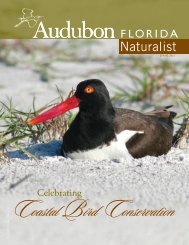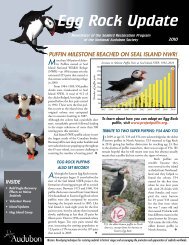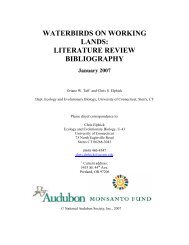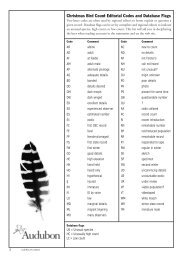Full report [PDF] - the Boreal Songbird Initiative
Full report [PDF] - the Boreal Songbird Initiative
Full report [PDF] - the Boreal Songbird Initiative
You also want an ePaper? Increase the reach of your titles
YUMPU automatically turns print PDFs into web optimized ePapers that Google loves.
Swamp SparrowPhoto/Mary Kay RubeyThe <strong>Boreal</strong> Forest Region:North America’s Bird NurseryPeter BlancherCanadian Wildlife ServiceNational Wildlife Research Centre, Carleton University, Raven Road,Ottawa, ON, K1A 0H3; Peter.Blancher@ec.gc.caJeffrey Wells<strong>Boreal</strong> <strong>Songbird</strong> <strong>Initiative</strong> Suite 615, 1601 Second Avenue, Seattle, WA 98101; jeffwells@borealbirds.orgThe <strong>Boreal</strong> Forest Region of North America, stretching from Alaska across 6,000kilometers (3,500 miles) to Newfoundland and Labrador, at 5.9 million square kilometers(1.5 billion acres), is <strong>the</strong> largest wilderness left in North America and represents25 percent of <strong>the</strong> world’s remaining intact forests (CBI 2005). Its vastness also makesit one of <strong>the</strong> few remaining places on earth where entire ecosystems function. Theseecosystems support some of <strong>the</strong> greatest abundance of wildlife on <strong>the</strong> continent,including massive caribou herds, intact predator-prey systems with healthy populationsof top predators like wolves, and large numbers of birds (Ricketts et al. 1999).This <strong>report</strong> was originally published inApril 2005. The study was commissionedby <strong>the</strong> <strong>Boreal</strong> <strong>Songbird</strong> <strong>Initiative</strong> and <strong>the</strong>Canadian <strong>Boreal</strong> <strong>Initiative</strong>.While all this has been known aboutNorth America’s <strong>Boreal</strong> Forest Region,its importance has sometimes been overlookedprecisely because of its abundantwildlife. Most global level conservationassessments of large ecoregions havefocused on <strong>the</strong> number of differentspecies of animals and plants (Karievaand Marvier 2003). Areas with a highnumber of different species tend to bePeter Blancher, Ph.D., recently returned to Environment Canada’s Canadian Wildlife Service after four years as Partners in Flight (PIF) Scientist with Bird StudiesCanada. He continues to provide technical support for landbird conservation planning at continental, national, and regional scales. As a member of <strong>the</strong> PIF ScienceCommittee, he is a co-author of <strong>the</strong> Partners in Flight North American Landbird Conservation Plan.Jeffrey Wells, Ph.D., is <strong>the</strong> senior scientist for <strong>the</strong> <strong>Boreal</strong> <strong>Songbird</strong> <strong>Initiative</strong>. He was a senior scientist with <strong>the</strong> Cornell Lab of Ornithology and served as Audubon’sNational Bird Conservation Director for many years. He has published more than 100 academic papers, technical <strong>report</strong>s, and popular articles about birds andbird conservation.30 AMERICAN BIRDS
given more attention, especially when many of those species have become rare sothat <strong>the</strong>y can rightly be considered endangered. In contrast, <strong>the</strong> <strong>Boreal</strong> ForestRegion has lower species diversity and fewer rare species than most tropical regions,and significant threats to <strong>the</strong> <strong>Boreal</strong> Forest Region ecosystem have only recentlybecome more widely understood (CBI 2005, Schmiegelow et al., unpubl. ms).In recent years, some scientists and conservation organizations have begun consideringabundance and intactness of ecosystems as equally important factors indeveloping conservation priorities (Karieva and Marvier 2003, Ricketts et al. 1999,Schmiegelow et al., unpubl. ms). Through its Important Bird Areas program,BirdLife International was one of <strong>the</strong> first organizations to explicitly consider abundanceas well as rarity in conservation (Chipley et al. 2003, Fishpool and Evans2001, Heath and Evans 2000, Wells 1998, Wells et al. 2005). More recently, <strong>the</strong>Partners In Flight coalition and its members have highlighted <strong>the</strong> concept that someregions have a high stewardship responsibility for maintaining species that are stillabundant (Rich et al. 2004, Rosenberg and Wells 2005, Rosenberg and Wells 2000,Wells and Rosenberg 1999, Rosenberg and Wells 1995).This <strong>report</strong> analyzes, for <strong>the</strong> first time, <strong>the</strong> stewardship responsibility of a globalscale ecosystem toward a continent’s wildlife—in this case, North America’s avianpopulations. Specifically we answer <strong>the</strong> following questions.How many bird species use North America’s <strong>Boreal</strong> Forest Region?What types of birds use North America’s <strong>Boreal</strong> Forest Region?How many birds in total rely on North America’s <strong>Boreal</strong> Forest Region?How many and what kinds of species are particularly reliant on North America’s <strong>Boreal</strong>Forest Region?How important is North America’s <strong>Boreal</strong> Forest Region for birds during spring and fallmigration?Where do birds that breed in North America’s <strong>Boreal</strong> Forest Region spend <strong>the</strong> winter?Key Findings■ Eighty percent of <strong>the</strong> waterfowlspecies of North America, 63 percentof finch species, and 53 percent ofwarbler species breed in <strong>the</strong> <strong>Boreal</strong>Forest Region.■ In at least 96 species, 50 percentor more of <strong>the</strong>ir entire breedingpopulations occur within <strong>the</strong><strong>Boreal</strong> Forest Region.■ Nearly 100 percent of <strong>the</strong> globalpopulations of <strong>the</strong> Bonaparte’sGull, <strong>the</strong> Palm Warbler, and <strong>the</strong>Short-billed Dowitcher nest within<strong>the</strong> <strong>Boreal</strong> Forest Region.■ Over 80 percent of <strong>the</strong> populationsof <strong>the</strong> coastal wintering White-wingedScoter, <strong>the</strong> rapidly disappearingRusty Blackbird, and <strong>the</strong> massiveGreat Gray Owl nest in <strong>the</strong> <strong>Boreal</strong>Forest Region.Delineation of North America’s <strong>Boreal</strong> Forest RegionAnalyses in this <strong>report</strong> are based on <strong>the</strong> area within <strong>the</strong> following four BirdConservation Regions (BCRs, U.S. NABCI Committee 2000; Figure 1).• BCR 4: Northwestern Interior Forest• BCR 6: <strong>Boreal</strong> Forest Region Taiga Plains• BCR 7: Taiga Shield and Hudson Plains• BCR 8: <strong>Boreal</strong> Forest Region Softwood Shield1234Figure 1. Bird Conservation Regions inNorth America’s <strong>Boreal</strong> Forest Region 1 .1: Northwestern Interior Forest (BCR 4),2: <strong>Boreal</strong> Forest Region Taiga Plains (BCR6), 3: Taiga Shield and Hudson Plains(BCR 7), 4: <strong>Boreal</strong> Forest RegionSoftwood Shield (BCR 8).1 The Canadian <strong>Boreal</strong> <strong>Initiative</strong> (CBI) defines <strong>the</strong> Canadian <strong>Boreal</strong> region using <strong>the</strong> National Ecological Framework for Canada Ecozones (NEFC). The followingNEFC ecozones are considered to be <strong>Boreal</strong>: <strong>Boreal</strong> Shield, <strong>Boreal</strong> Cordillera, <strong>Boreal</strong> Plains, Taiga Shield, Taiga Cordillera, Taiga Plains, and Hudson Plains.The Canadian Bird Conservation Regions in Figure 1 approximate Canada’s <strong>Boreal</strong> region according to <strong>the</strong> CBI definition, although some differences exist.THE 105TH CHRISTMAS BIRD COUNT AMERICAN BIRDS 31
How many bird species use North America’s <strong>Boreal</strong> Forest Region?Nearly 400 species (399 or 57 percent of regularly occurring birds of <strong>the</strong> UnitedStates and Canada) are known to occur within some portion of <strong>the</strong> <strong>Boreal</strong> ForestRegion of Alaska and Canada. Excluding species that are exclusively marine orcoastal or that occur in only a tiny portion of <strong>the</strong> <strong>Boreal</strong> Forest Region, <strong>the</strong>re are325 species (47 percent) that occur regularly in <strong>the</strong> <strong>Boreal</strong> Forest Region (Appendix1). Of <strong>the</strong>se, 303 species (43 percent) breed in <strong>the</strong> forests, thickets, and wetlands of<strong>the</strong> <strong>Boreal</strong> Forest Region. The remaining 22 species occur as migrants or wintererswithin <strong>the</strong> region.What types of birds use North America’s <strong>Boreal</strong> Forest Region?The array of types and families of birds that regularly use <strong>the</strong> <strong>Boreal</strong> Forest Regionis impressive. At least 47 families of birds are represented, making up 67 percent ofall bird families that regularly occur in <strong>the</strong> United States and Canada. The listincludes loons, grebes, swans, ducks, hawks, sandpipers, gulls, owls, vireos, flycatchers,warblers, and sparrows. Certain families have an especially high representationin <strong>the</strong> <strong>Boreal</strong> Forest Region. Thirty-five of 44 waterfowl species (80 percent) in <strong>the</strong>United States or Canada breed in <strong>the</strong> <strong>Boreal</strong> Forest Region. Similarly, among warblers,27 of 51 species (53 percent) that nest in <strong>the</strong> United States or Canada breedin <strong>the</strong> <strong>Boreal</strong> Forest Region. Among thrushes, 13 of <strong>the</strong> 14 thrush species (93 percent)that nest in <strong>the</strong> United States and Canada are <strong>Boreal</strong> Forest Region breeders.Among finches, <strong>the</strong> number is 10 of 16 (63 percent).How many birds in total rely on North America’s <strong>Boreal</strong> Forest Region?The number of birds breeding in North America’s <strong>Boreal</strong> Forest Region is estimatedat between 1.65 and 3 billion (Table 1). Of <strong>the</strong>se, landbirds are by far <strong>the</strong>most numerous, making up 97 percent of all birds that breed in <strong>the</strong> <strong>Boreal</strong> ForestTable 1. Estimated number of birds breeding in North America’s <strong>Boreal</strong> Forest Regionby bird group.Bird Group Estimated Breeding Population % of U.S./Canada PopulationLandbirds 1,600,000,000 30%Shorebirds 7,000,000 30%Waterbirds 14,000,000 n/aWaterfowl 26,000,000 38%American Bittern32 AMERICAN BIRDS
Table 3. Species with 25–49 percent of estimated Western Hemisphere breedingpopulation in North America’s <strong>Boreal</strong> Forest Region (55 species).Greater White-fronted GooseCanada GooseNor<strong>the</strong>rn ShovelerNor<strong>the</strong>rn PintailCommon EiderLong-tailed DuckRed-breasted MerganserDouble-crested CormorantAmerican BitternOspreySharp-shinned HawkNor<strong>the</strong>rn GoshawkBroad-winged HawkSandhill CraneAmerican Golden-PloverSemipalmated SandpiperDunlinStilt SandpiperAmerican WoodcockFranklin’s GullBlack TernLong-eared OwlBelted KingfisherHairy WoodpeckerNor<strong>the</strong>rn FlickerWestern Wood-PeweeEastern PhoebeRed-eyed VireoBlack-billed MagpieTree SwallowBank SwallowBlack-capped ChickadeeRed-breasted NuthatchWinter WrenGolden-crowned KingletArctic WarblerVeeryAmerican RobinVaried ThrushAmerican PipitCedar WaxwingYellow WarblerChestnut-sided WarblerAmerican RedstartOvenbirdAmerican Tree SparrowChipping SparrowSavannah SparrowNelson’s Sharp-tailed SparrowSmith’s LongspurRose-breasted GrosbeakPurple FinchCommon RedpollPine SiskinEvening GrosbeakTable 4. Species with more than 80 percent of estimated Western Hemisphere breedingpopulation in North America’s <strong>Boreal</strong> Forest Region (35 species).Surf ScoterBonaparte’s GullBohemian WaxwingWhite-winged ScoterHerring GullTennessee WarblerBlack ScoterGreat Gray OwlCape May WarblerBuffleheadAmerican Three-toedPalm WarblerCommon GoldeneyeWoodpeckerBlackpoll WarblerLesser YellowlegsPhoto © Ducks Unlimited CanadaSpruce GrouseRed-necked GrebeWhooping CraneBlack-backed WoodpeckerYellow-bellied FlycatcherAlder FlycatcherConnecticut WarblerLincoln’s SparrowWhite-throated SparrowLesser YellowlegsNor<strong>the</strong>rn ShrikeDark-eyed JuncoSolitary SandpiperPhiladelphia VireoRusty BlackbirdSurfbirdGray JayPine GrosbeakShort-billed Dowitcher<strong>Boreal</strong> ChickadeeWhite-winged CrossbillMore than 80 percent of <strong>the</strong> populations of 35 species are found in <strong>the</strong> <strong>Boreal</strong>Forest Region (Table 4). This includes a surprising variety of species, including PalmWarbler (> 90 percent of population in <strong>Boreal</strong> Forest Region), Short-billed Dowitcher(> 90 percent of population in <strong>Boreal</strong> Forest Region), Nor<strong>the</strong>rn Shrike, (> 90 percent),Bonaparte’s Gull (> 90 percent), Spruce Grouse (> 90 percent), Red-necked Grebe(> 90 percent), Gray Jay (80–90 percent), Bufflehead (80–90 percent), White-wingedScoter (80–90 percent), Rusty Blackbird (80–90 percent), and Great Gray Owl(80–90 percent). For <strong>the</strong>se species, <strong>the</strong> <strong>Boreal</strong> Forest Region is virtually <strong>the</strong>ir onlystronghold on earth.How important is North America’s <strong>Boreal</strong> Forest Regionfor birds during spring and fall migration?Virtually all species of boreal nesting birds also make use of parts of <strong>the</strong> <strong>Boreal</strong>Forest Region during migration. Some birds rely more on <strong>the</strong> <strong>Boreal</strong> Forest Regionfor migratory stopover habitat than for breeding or wintering. These 29 bird species(Table 5) include some that do not breed anywhere in <strong>the</strong> <strong>Boreal</strong> Forest Region. For34 AMERICAN BIRDS
Table 5. Species in which <strong>the</strong> area of North America’s <strong>Boreal</strong> Forest Region occupiedduring migration exceeds <strong>the</strong> area occupied during breeding or wintering (29 species).Greater White-fronted GooseSnow GooseRoss’s GooseBrantCackling GooseTundra SwanGadwallRough-legged HawkWhooping CraneBlack-bellied PloverAmerican Golden-PloverPacific Golden-PloverSemipalmated PloverHudsonian GodwitRed KnotSanderlingSemipalmated SandpiperWhite-rumped SandpiperBaird’s SandpiperPectoral SandpiperDunlinStilt SandpiperBuff-breasted SandpiperLong-billed DowitcherAmerican PipitHarris’s SparrowLapland LongspurSmith’s LongspurSnow Buntingexample, <strong>the</strong> White-rumped Sandpiper does not breed in <strong>the</strong> <strong>Boreal</strong> Forest Regionbut makes extensive use of wetlands within <strong>the</strong> <strong>Boreal</strong> Forest Region during its falland spring migration. O<strong>the</strong>r shorebirds, like <strong>the</strong> Pectoral Sandpiper, which haveinsignificant portions of <strong>the</strong> breeding range in <strong>the</strong> <strong>Boreal</strong> zone, are also highly relianton <strong>Boreal</strong> Forest Region wetlands during migration. Waterfowl, like <strong>the</strong> GreaterWhite-fronted Goose, Snow Goose, Cackling Goose, Tundra Swan, and GreaterScaup, also regularly migrate through a large part of <strong>the</strong> <strong>Boreal</strong> Forest Region. Notquantified here is use of <strong>the</strong> <strong>Boreal</strong> Forest Region by “molt-migrants,” birds thatmigrate north into <strong>the</strong> <strong>Boreal</strong> Forest Region after breeding to undergo molt, a practicecommon among many waterfowl species.Green-winged TealPhoto © Ducks Unlimited CanadaWhere do birds that breed in North America’s <strong>Boreal</strong> Forest Region spend <strong>the</strong> winter?Approximately 94 percent of individual birds migrate out of <strong>the</strong> <strong>Boreal</strong> ForestRegion after breeding, judging by migratory shifts in range between breeding andwintering grounds. These <strong>Boreal</strong> migrants winter in many countries throughout <strong>the</strong>Western Hemisphere, with several species wintering outside of <strong>the</strong> hemisphere. Morespecies winter in <strong>the</strong> United States (lower 48) than in any o<strong>the</strong>r country or region—a total of 204 species or approximately 63 percent of <strong>Boreal</strong> Forest Region breedingbirds (Table 6). Mexico is a close second in importance, with 190 species (59 percent),followed by Central America (115 species, 36 percent), South America (87species, 27 percent) and <strong>the</strong> Caribbean (86 species, 27 percent). If species with lessthan 10 percent of <strong>the</strong>ir breeding range in <strong>the</strong> <strong>Boreal</strong> Forest Region are excluded, <strong>the</strong>number of migrant species wintering in all of <strong>the</strong>se regions is still high, ranging from59 species wintering in South America, to 137 in <strong>the</strong> United States (Table 6).Several of <strong>the</strong>se species winter largely in a single country or region. AmericanBlack Ducks, Yellow Rails, Rusty Blackbirds, Smith’s Longspurs, Harris’s Sparrows,and Golden-crowned Sparrows are among species in which virtually <strong>the</strong> entire winteringpopulation occurs only within <strong>the</strong> United States. Virtually all Cape MayWarblers winter in <strong>the</strong> Caribbean. Most Baird’s Sparrows winter in Mexico, whileYellow-bellied Flycatchers, Philadelphia Vireos, Wilson’s Warblers, and MagnoliaWarblers are restricted in winter to Mexico and Central America. Birds like <strong>the</strong>Table 6. Number of species of boreal migrants by wintering region (excluding species with1% breed in <strong>Boreal</strong> Forest Region 204 190 115 86 87>10% breed in <strong>Boreal</strong> Forest Region 137 128 81 65 59THE 105TH CHRISTMAS BIRD COUNT AMERICAN BIRDS 35
Hudsonian Godwit, Blackpoll Warbler, and Connecticut Warbler are among thosefound only in South America in winter. And <strong>the</strong> Arctic Tern, a breeding bird of wetlandsin <strong>the</strong> western <strong>Boreal</strong> Forest Region, winters in <strong>the</strong> sub-Antarctic Ocean.Of <strong>the</strong> 276 species with 5 percent or more of <strong>the</strong>ir breeding range in <strong>the</strong> <strong>Boreal</strong>Forest Region, only a hardy 44 have 5 percent or more of <strong>the</strong>ir wintering range within<strong>the</strong> <strong>Boreal</strong> Forest Region (Table 7). Fifteen species are highly reliant on <strong>Boreal</strong>Forest Region lands for 50 percent or more of <strong>the</strong>ir winter range. Some of <strong>the</strong>se—<strong>the</strong> essentially non-migratory species—rely on <strong>the</strong> <strong>Boreal</strong> Forest Region year-round.Such species include <strong>the</strong> <strong>Boreal</strong> Chickadee, Nor<strong>the</strong>rn Hawk-Owl, Gray Jay, SpruceGrouse, Great Gray Owl, <strong>Boreal</strong> Owl, American Three-toed Woodpecker, BlackbackedWoodpecker, and Willow Ptarmigan.Table 7. Species with more than 5 percent of Western Hemisphere wintering range in NorthAmerica’s <strong>Boreal</strong> Forest Region (44 species).Gray PartridgeRuffed GrouseSpruce GrouseWillow PtarmiganRock PtarmiganWhite-tailed PtarmiganBlue GrouseSharp-tailed GrouseNor<strong>the</strong>rn GoshawkGolden EagleGyrfalconGreat Horned OwlSnowy OwlNor<strong>the</strong>rn Hawk OwlBarred OwlGreat Gray Owl<strong>Boreal</strong> OwlDowny WoodpeckerHairy WoodpeckerAmerican Three-toedWoodpeckerBlack-backed WoodpeckerPileated WoodpeckerNor<strong>the</strong>rn ShrikeGray JayBlue JayBlack-billed MagpieCommon RavenBlack-capped Chickadee<strong>Boreal</strong> ChickadeeGray-headed ChickadeeRed-breasted NuthatchBrown CreeperAmerican DipperEuropean StarlingBohemian WaxwingSnow BuntingPine GrosbeakRed CrossbillWhite-winged CrossbillCommon RedpollHoary RedpollPine SiskinEvening GrosbeakHouse Sparrow36 AMERICAN BIRDS
Data, Analyses, and LimitationsMost analyses in this <strong>report</strong> rely on two datasets, chosen for <strong>the</strong>ir applicability to<strong>the</strong> greatest number of species and comparability with o<strong>the</strong>r parts of North Americaand <strong>the</strong> Western Hemisphere.The first is Digital Distribution Maps of <strong>the</strong> Birds of <strong>the</strong> Western Hemisphere(Ridgely et al. 2003). Shape files of <strong>the</strong>se maps were overlain with jurisdictional outlinesand Bird Conservation Regions to measure <strong>the</strong> proportion of breeding, wintering,and transient range of each species in <strong>the</strong> <strong>Boreal</strong> Forest Region and elsewhere.An implicit assumption in <strong>the</strong> use of distribution maps is that a region’s importanceto a species is strongly related to <strong>the</strong> proportion of that species’ range in <strong>the</strong>region. This assumption is reasonable for most species, but may break down forspecies with highly clumped distributions, such as breeding seabirds and o<strong>the</strong>rcolonial waterbirds. For <strong>the</strong>se species, use of colony counts if available across aspecies range would provide a more accurate assessment of relative importance of<strong>the</strong> <strong>Boreal</strong> Forest Region.The second dataset is from <strong>the</strong> North American Breeding Bird Survey (BBS). Data from <strong>the</strong> 1990s decade were analyzed to providean alternative measure of <strong>the</strong> proportion of breeding birds of each species in combinationsof jurisdiction and BCR within <strong>the</strong> United States, and within Canadasouth of <strong>the</strong> Arctic. These data also provided a means to estimate population sizesof landbirds (for methods, see Rich et al. 2004) and for some additional specieswithout published estimates in continental conservation plans.BBS analyses in <strong>the</strong> <strong>Boreal</strong> Forest Region were based on a reasonably high numberof individual survey routes (265 with data from <strong>the</strong> 1990s). However, <strong>the</strong>distribution of routes is biased toward <strong>the</strong> sou<strong>the</strong>rn parts of <strong>the</strong> <strong>Boreal</strong> ForestRegion. Routes were stratified by province/state/territory and BCR to minimizeeffects of this bias, but low sample size in <strong>the</strong> nor<strong>the</strong>rn parts of <strong>the</strong> <strong>Boreal</strong> ForestRegion results in low precision in estimates of bird numbers for many species.Some species, particularly many non-landbirds, are not sampled well by BBS surveys.For this reason, estimates of population sizes of shorebirds, waterfowl, andwaterbirds relied on continental estimates provided in continental plans(Donaldson et al. 2000 and Brown et al. 2001 for shorebirds, Kushlan et al. 2002and Milko et al. 2003 for waterbirds, and NAWMP 2004 for waterfowl).Continental estimates were multiplied by proportion of range or proportion ofBBS population in <strong>the</strong> <strong>Boreal</strong> Forest Region to give an approximate estimate ofbreeding population size in <strong>the</strong> <strong>Boreal</strong> Forest Region. For waterfowl in particular,a more accurate estimate of <strong>the</strong> proportion of continental populations that occurin <strong>the</strong> <strong>Boreal</strong> Forest Region should be possible with <strong>the</strong> use of various waterfowlsurvey datasets, not treated in this <strong>report</strong>.Proportions of Western Hemisphere population for all birds were based on a combinationof BBS proportions within <strong>the</strong> BBS survey area, and proportion ofbreeding range elsewhere in <strong>the</strong> hemisphere.Lists of birds present in <strong>the</strong> <strong>Boreal</strong> Forest Region were screened against lists ofbirds assigned to <strong>Boreal</strong> BCRs in continental bird conservation plans (those in previousparagraph, plus Rich et al. 2004 for landbirds), and in various breeding birdatlases, resulting in some additions and deletions from BBS and range data.AcknowledgmentsThis <strong>report</strong> was modeled after a previous <strong>report</strong> on <strong>the</strong> importance of Canada’s<strong>Boreal</strong> Forest Region to landbirds in <strong>the</strong> Western Hemisphere (Blancher 2003).However, analyses <strong>report</strong>ed here were updated to incorporate more recent data, andexpanded to include non-landbirds and <strong>the</strong> full extent of <strong>the</strong> North American<strong>Boreal</strong> Forest Region, including much of Alaska.Bird Studies Canada is recognizednationwide as a leading and respectednot-for-profit conservationorganization dedicated to advancing<strong>the</strong> understanding, appreciation, andconservation of wild birds and <strong>the</strong>irhabitats, in Canada and elsewhere,through studies that engage <strong>the</strong> skills,enthusiasm, and support of its members,volunteers, staff, and <strong>the</strong>interested public.The <strong>Boreal</strong> <strong>Songbird</strong> <strong>Initiative</strong> (BSI)is a non-profit organization dedicatedto educating Americans about <strong>the</strong>importance of <strong>the</strong> <strong>Boreal</strong> Forest tomigratory birds. BSI is part of <strong>the</strong><strong>Boreal</strong> <strong>Songbird</strong> Network, a networkof U.S. organizations, including <strong>the</strong>American Bird Conservancy, DucksUnlimited, <strong>the</strong> National WildlifeFederation, Defenders of Wildlife, <strong>the</strong>Audubon Society, and <strong>the</strong> NaturalResources Defense Council, workingto raise awareness about <strong>the</strong> <strong>Boreal</strong>Forest and assist efforts in Canadaand Alaska to conserve it.The Canadian <strong>Boreal</strong> <strong>Initiative</strong>was created in response to both <strong>the</strong>opportunities and threats facingCanada’s <strong>Boreal</strong> Forest Region.Based in Ottawa, CBI brings toge<strong>the</strong>ra wide range of conservation organizations,First Nations, industryleaders, and o<strong>the</strong>rs to create newsolutions for boreal conservation andsustainable development. It supportsscientific research to advance thinkingon conservation-based planningfor <strong>the</strong> <strong>Boreal</strong> Forest Region, andacts as a catalyst by supporting avariety of on-<strong>the</strong>-ground effortsacross <strong>the</strong> boreal by conservationgroups, First Nations, and o<strong>the</strong>rs.In 2003, CBI convened <strong>the</strong> <strong>Boreal</strong>Leadership Council, an extraordinarygroup of conservation organizations,First Nations, and resource companies.In concert with members of <strong>the</strong>council, CBI developed and launched<strong>the</strong> <strong>Boreal</strong> Forest ConservationFramework—a vision for <strong>the</strong> protectionand sustainable development ofCanada’s entire boreal ecosystem.THE 105TH CHRISTMAS BIRD COUNT AMERICAN BIRDS 37
Species range information came largelyfrom Ridgely et al. (2003) shape files.These data were provided by NatureServein collaboration with Robert Ridgely,James Zook, The Nature Conservancy-Migratory Bird Program, ConservationInternational-Center for AppliedBiodiversity Science, World WildlifeFund-US, and Environment Canada-Wildspace. Thanks especially to AndrewCouturier, Bird Studies Canada, whooverlaid <strong>the</strong>se shape files onto jurisdictionalmaps, a BCR layer, and lat/longdegree blocks, thus enabling us to calculateproportions of range for eachspecies. And thanks to EnvironmentCanada, Ontario Region, for providing<strong>the</strong> BCR shape file used for analyses inthis <strong>report</strong>.Breeding Bird Survey data wereobtained from <strong>the</strong> very useful U.S.Geological Survey web pages devoted tothis survey. The methods of estimatingpopulation size from BBS data weredeveloped in conjunction with KenRosenberg (Cornell Lab of Ornithology)and with input from <strong>the</strong> Partners inFlight Science Committee during developmentof <strong>the</strong> PIF North AmericanLandbird Conservation Plan (Rich et al.2004). We would also like to thank <strong>the</strong>thousands of volunteers who collected<strong>the</strong> data used here.ReferencesBlancher, P. 2003. Importance of Canada’s <strong>Boreal</strong>Forest to Landbirds. Canadian <strong>Boreal</strong> <strong>Initiative</strong> and<strong>Boreal</strong> <strong>Songbird</strong> <strong>Initiative</strong>, Ottawa, ON, andSeattle, WA.Brown, S., C. Hickey, B. Harrington, and R. Gill (eds).2001. United States Shorebird Conservation Plan,2nd Edition. Manomet Center for ConservationSciences, Manomet, MA.Canadian <strong>Boreal</strong> <strong>Initiative</strong>. 2005. The <strong>Boreal</strong> in <strong>the</strong>Balance: Securing <strong>the</strong> Future of Canada’s <strong>Boreal</strong>Forest Region. Canadian <strong>Boreal</strong> <strong>Initiative</strong>,Ottawa, ON.Chipley, R. M., G. H. Fenwick, M. J. Parr, and D. N.Pashley. 2003. The American Bird ConservancyGuide to <strong>the</strong> 500 Most Important Bird Areas in <strong>the</strong>United States. Random House, New York.Donaldson, G. M., C. Hyslop, R. I. G. Morrison, H. L.Dickson, and I. Davidson (eds). 2000. CanadianShorebird Conservation Plan. Canadian WildlifeService, Hull, QC.Fishpool, L. D. C., and M. I. Evans. 2001. Importantbird areas in Africa and associated islands: prioritysites for conservation. Cambridge, UK: BirdlifeInternational: 1144 pp.Heath, M. F., and M. I. Evans, eds. 2000. Importantbird areas in Europe: Priority sites for conservation.2 vols. Cambridge, UK: BirdLife International.Karieva, P., and M. Marvier. 2003. Conserving BiodiversityColdspots. American Scientist 91(4): 344.Kushlan, J. A., M. J. Steinkamp, K. C. Parsons, J. Capp,M. A. Cruz, M. Coulter, I. Davidson, L. Dickson, N.Edelson, R. Elliot, R. M. Erwin, S. Hatch, S. Kress, R.Milko, S. Miller, K. Mills, R. Paul, R. Phillips, J. E.Saliva, B. Sydeman, J. Trapp, J. Wheeler, and K.Wohl. 2002. Waterbird Conservation for <strong>the</strong>Americas: The North American WaterbirdConservation Plan, Version 1. Waterbird Conservationfor <strong>the</strong> Americas, Washington, DC.Milko, R., L. Dickson, R. Elliot, and G. Donaldson.2003. Wings Over Water: Canada’s WaterbirdConservation Plan. Canadian Wildlife Service,Ottawa, ON.NAWMP. 2004. 2004 North American WaterfowlManagement Plan–Streng<strong>the</strong>ning <strong>the</strong> BiologicalFoundation. U.S. Fish and Wildlife Service,Arlington,VA; Direccion General de Vida Silvestre, Mexico, DF;Canadian Wildlife Service, Gatineau, QC.Rich, T. D., C. J. Beardmore, H. Berlanga, P. J. Blancher,M. S. W. Bradstreet, G. S. Butcher, D. W. Demarest,E. H. Dunn, W. C. Hunter, E. E. Inigo-Elias, J. A.Kennedy, A. M. Martell, A. O. Panjabi, D. N. Pashley,K. V. Rosenberg, C. M. Rustay, J. S. Wendt, and T. C.Will. 2004. Partners in Flight North AmericanLandbird Conservation Plan. Cornell Lab ofOrnithology, Ithaca, NY.Ricketts, T. H., E. Dinerstein, D. M. Olson, C. J. Louckset al. 1999. Terrestrial Ecoregions of NorthAmerica: A Conservation Assessment. IslandPress, Washington, DC, 485 pp.Ridgely, R. S., T. F. Allnutt, T. Brooks, D. K. McNicol, D. W.Mehlman, B. E. Young, and J. R. Zook. 2003. DigitalDistribution Maps of <strong>the</strong> Birds of <strong>the</strong> WesternHemisphere, version 1.0. NatureServe,Arlington,VA.Rosenberg, K. V., and J. V. Wells. 1995. Importance ofgeographic areas to Neotropical migrants in <strong>the</strong>Nor<strong>the</strong>ast. Final <strong>report</strong> to U.S. Fish and WildlifeService, Region 5, Hadley, MA.Rosenberg, K. V., and J. V. Wells. 2000. Globalperspectives on neotropical migratory bird conservationin <strong>the</strong> Nor<strong>the</strong>ast: long-term responsibilityversus immediate concern. Pp. 32–43 In (R.Bonney, D. N. Pashley, R. J. Cooper, and L. Niles,eds.) Strategies for bird conservation: The PartnersIn Flight planning process; Proceedings of <strong>the</strong> 3rdPartners In Flight Workshop; 1995 October 1–5;Cape May, NJ. Proceedings RMRS-P-16. U.S.Department of Agriculture, Forest Service, RockyMountain Research Station, Ogden, UT.Rosenberg, K. V., and J. V. Wells. 2005. ConservationPriorities for Terrestrial Birds in <strong>the</strong> Nor<strong>the</strong>asternUnited States. In (C. J. Ralph and T. D. Rich, eds.)Bird Conservation Implementation and Integrationin <strong>the</strong> Americas: Proceedings of <strong>the</strong> ThirdInternational Partners In Flight Conference 2002.USDA Forest Service, GTR-PSW-191, Albany, CA.Schmiegelow, F. K. A., S. G. Cumming, S. Harrison, S.Leroux, K. Lisgo, and B. Olsen. Unpublished manuscript.Conservation beyond crisis management:<strong>the</strong> matrix reclaimed.U.S. NABCI Committee. 2000. North American BirdConservation <strong>Initiative</strong>. Bird Conservation RegionsMap & Bird Conservation Region Descriptions.U.S. Fish and Wildlife Service, Arlington, VA.Wells, J. V. 1998. Important Bird Areas in New YorkState.Albany, NY: National Audubon Society; 243 pp.Wells, J. V., and K. V. Rosenberg. 1999. Grassland birdconservation in nor<strong>the</strong>astern North America.Studies in Avian Biology No. 19:72–80.Wells, J. V., D. K. Niven, and J. Cecil. 2005. TheImportant Bird Areas Program in <strong>the</strong> United States,Building a Network of Sites for Conservation, Stateby State. In (C. J. Ralph and T. D. Rich, eds.) BirdConservation Implementation and Integration in<strong>the</strong> Americas: Proceedings of <strong>the</strong> ThirdInternational Partners In Flight Conference 2002.USDA Forest Service, GTR-PSW-191, Albany, CA.38 AMERICAN BIRDS
Appendix 1. Bird species that regularly occur in North America’s <strong>Boreal</strong> Forest Region during breeding, migration,or wintering seasons (325 species).Greater White-frontedGooseSnow GooseRoss’s GooseBrantCackling GooseCanada GooseTrumpeter SwanTundra SwanWood DuckGadwallAmerican WigeonAmerican Black DuckMallardBlue-winged TealNor<strong>the</strong>rn ShovelerNor<strong>the</strong>rn PintailGreen-winged TealCanvasbackRedheadRing-necked DuckGreater ScaupLesser ScaupCommon EiderHarlequin DuckSurf ScoterWhite-winged ScoterBlack ScoterLong-tailed DuckBuffleheadCommon GoldeneyeBarrow’s GoldeneyeHooded MerganserCommon MerganserRed-breastedMerganserRuddy DuckGray PartridgeRing-necked PheasantRuffed GrouseSpruce GrouseWillow PtarmiganRock PtarmiganWhite-tailed PtarmiganBlue GrouseSharp-tailed GrouseRed-throated LoonPacific LoonCommon LoonYellow-billed LoonPied-billed GrebeHorned GrebeRed-necked GrebeEared GrebeWestern GrebeAmerican White PelicanDouble-crestedCormorantAmerican BitternGreat Blue HeronBlack-crowned Night-HeronOspreyBald EagleNor<strong>the</strong>rn HarrierSharp-shinned HawkCooper’s HawkNor<strong>the</strong>rn GoshawkRed-shouldered HawkBroad-winged HawkSwainson’s HawkRed-tailed HawkRough-legged HawkGolden EagleAmerican KestrelMerlinGyrfalconPeregrine FalconPrairie FalconYellow RailVirginia RailSoraAmerican CootSandhill CraneWhooping CraneBlack-bellied PloverAmerican Golden-PloverPacific Golden-PloverSemipalmated PloverPiping PloverKilldeerEurasian DotterelAmerican AvocetGreater YellowlegsLesser YellowlegsSolitary SandpiperWilletWandering TattlerSpotted SandpiperUpland SandpiperWhimbrelBristle-thighed CurlewHudsonian GodwitBar-tailed GodwitMarbled GodwitRuddy TurnstoneBlack TurnstoneSurfbirdRed KnotSanderlingSemipalmatedSandpiperWestern SandpiperLeast SandpiperWhite-rumpedSandpiperBaird’s SandpiperPectoral SandpiperPurple SandpiperRock SandpiperDunlinStilt SandpiperBuff-breastedSandpiperShort-billed DowitcherLong-billed DowitcherWilson’s SnipeAmerican WoodcockWilson’s PhalaropeRed-necked PhalaropeRed PhalaropePomarine JaegerParasitic JaegerLong-tailed JaegerFranklin’s GullLittle GullBlack-headed GullBonaparte’s GullMew GullRing-billed GullCalifornia GullHerring GullThayer’s GullIceland GullLesser Black-backed GullGlaucous-winged GullGlaucous GullSabine’s GullRoss’s GullCaspian TernCommon TernArctic TernForster’s TernBlack TernRock PigeonMourning DoveBlack-billed CuckooGreat Horned OwlSnowy OwlNor<strong>the</strong>rn Hawk OwlNor<strong>the</strong>rn Pygmy-OwlBarred OwlGreat Gray OwlLong-eared OwlShort-eared Owl<strong>Boreal</strong> OwlNor<strong>the</strong>rn Saw-whet OwlCommon NighthawkWhip-poor-willChimney SwiftRuby-throatedHummingbirdRufous HummingbirdBelted KingfisherLewis’s WoodpeckerRed-headedWoodpeckerYellow-belliedSapsuckerRed-naped SapsuckerRed-breastedSapsuckerDowny WoodpeckerHairy WoodpeckerAmerican Three-toedWoodpeckerBlack-backedWoodpeckerNor<strong>the</strong>rn FlickerPileated WoodpeckerOlive-sided FlycatcherWestern Wood-PeweeEastern Wood-PeweeYellow-belliedFlycatcherAlder FlycatcherLeast FlycatcherHammond’s FlycatcherDusky FlycatcherPacific-slope FlycatcherEastern PhoebeSay’s PhoebeGreat CrestedFlycatcherEastern KingbirdLoggerhead ShrikeNor<strong>the</strong>rn ShrikeYellow-throated VireoCassin’s VireoBlue-headed VireoWarbling VireoPhiladelphia VireoRed-eyed VireoGray JayBlue JayClark’s NutcrackerBlack-billed MagpieAmerican CrowCommon RavenHorned LarkPurple MartinTree SwallowViolet-green SwallowNor<strong>the</strong>rn RoughwingedSwallowBank SwallowCliff SwallowBarn SwallowBlack-cappedChickadeeMountain ChickadeeChestnut-backedChickadee<strong>Boreal</strong> ChickadeeGray-headedChickadeeRed-breasted NuthatchWhite-breastedNuthatchBrown CreeperHouse WrenWinter WrenSedge WrenMarsh WrenAmerican DipperGolden-crownedKingletRuby-crowned KingletArctic WarblerBluethroatNor<strong>the</strong>rn WheatearEastern BluebirdMountain BluebirdTownsend’s SolitaireVeeryGray-cheeked ThrushBicknell’s ThrushSwainson’s ThrushHermit ThrushWood ThrushAmerican RobinVaried ThrushGray CatbirdBrown ThrasherEuropean StarlingEastern Yellow WagtailRed-throated PipitAmerican PipitSprague’s PipitBohemian WaxwingCedar WaxwingTennessee WarblerOrange-crownedWarblerNashville WarblerNor<strong>the</strong>rn ParulaYellow WarblerChestnut-sided WarblerMagnolia WarblerCape May WarblerBlack-throated BlueWarblerYellow-rumped WarblerBlack-throated GreenWarblerTownsend’s WarblerBlackburnian WarblerPine WarblerPalm WarblerBay-breasted WarblerBlackpoll WarblerBlack-and-whiteWarblerAmerican RedstartOvenbirdNor<strong>the</strong>rn WaterthrushConnecticut WarblerMourning WarblerMacGillivray’s WarblerCommon YellowthroatWilson’s WarblerCanada WarblerScarlet TanagerWestern TanagerSpotted TowheeEastern TowheeAmerican Tree SparrowChipping SparrowClay-colored SparrowBrewer’s SparrowVesper SparrowSavannah SparrowBaird’s SparrowLe Conte’s SparrowNelson’s Sharp-tailedSparrowFox SparrowSong SparrowLincoln’s SparrowSwamp SparrowWhite-throatedSparrowHarris’s SparrowWhite-crownedSparrowGolden-crownedSparrowDark-eyed JuncoLapland LongspurSmith’s LongspurSnow BuntingRose-breastedGrosbeakIndigo BuntingBobolinkRed-winged BlackbirdEastern MeadowlarkWestern MeadowlarkYellow-headedBlackbirdRusty BlackbirdBrewer’s BlackbirdCommon GrackleBrown-headed CowbirdBaltimore OrioleGray-crowned Rosy-FinchPine GrosbeakPurple FinchRed CrossbillWhite-winged CrossbillCommon RedpollHoary RedpollPine SiskinAmerican GoldfinchEvening GrosbeakHouse SparrowTHE 105TH CHRISTMAS BIRD COUNT AMERICAN BIRDS 39


![Full report [PDF] - the Boreal Songbird Initiative](https://img.yumpu.com/52893853/1/500x640/full-report-pdf-the-boreal-songbird-initiative.jpg)







